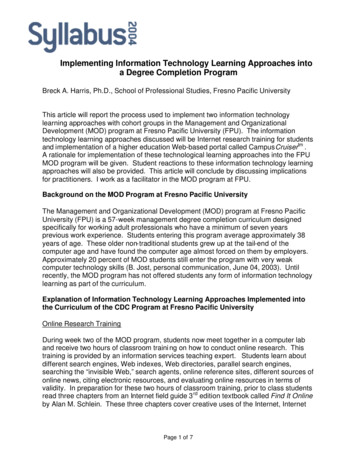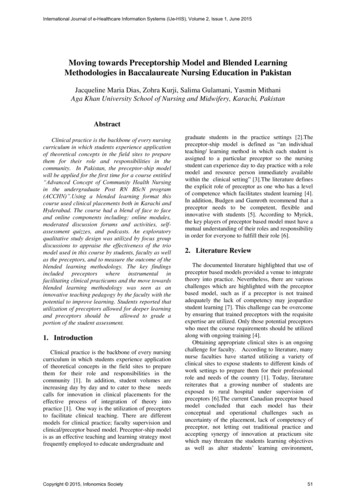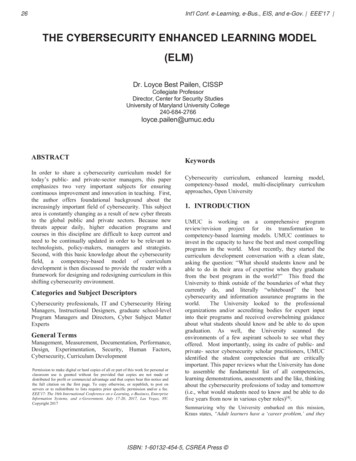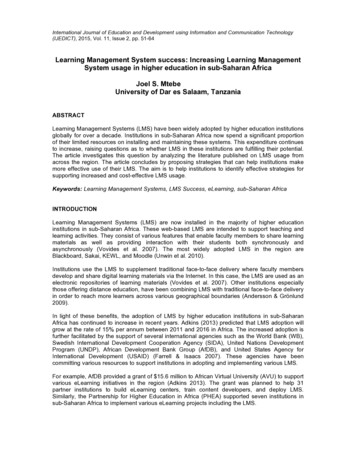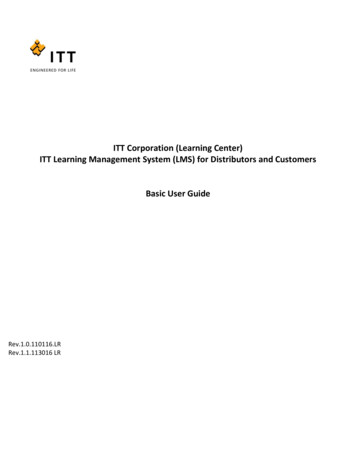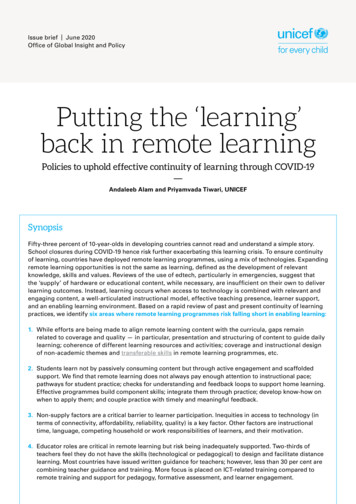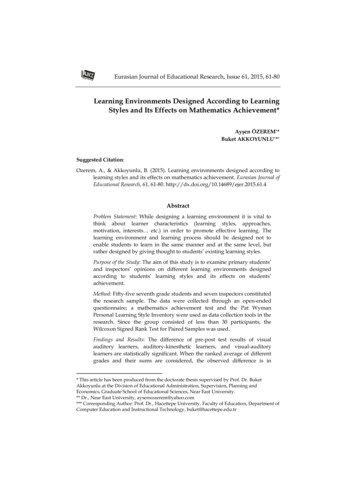
Transcription
Implementing theInspired Learning ModelJanuary 2021Written by current and former Washington State public school teachersand administrators affiliated with the Bellingham, Washington nonprofitorganization School Change Now.The Inspired Learning Model (ILM) can operate in US public elementary schools withexisting budgets and staffing levels. ILM can provide every child with the advantages ofstudent-centered education while meeting state student performance assessment expectations.Developing the Gold Standard in K-5 Global School Transformation
This page intentionally left blank
ContentsThe Inspired Learning Model1Leadership Team2Building Support Among All Stakeholders3Building Support Specifically Among Educators4Steps for Implementation6Overview of Costs7Dollar Amounts8The ILM Lab School9ILM Lab School Positions and Costs10Sources of Funding11Sample Timeline12Looking Forward13
The Inspired Learning ModelIn the student-centered* Inspired Learning Model (ILM), a school’s primary focus is oninvolvement and interactions. Students learn collaboratively in active settings that reflectreal-world experiences. Teachers and support staff are tasked with being attuned to eachchild’s unique needs, passions, strengths, and weaknesses. The connections builtbetween educators and students endure for the whole time the student attends a specificschool. Assessments are designed to provide opportunities for students to practice,enhance, refine, and demonstrate the knowledge and skills they have acquired. Thisapproach: Makes school more relevant and fun for children Gives students who are frustrated and bored anincentive to apply themselves Results in higher academic achievement Levels the playing field for children from variouscultural and socioeconomic backgrounds Improves parent-child relationships Improves student-teacher relationships Improves social skillsThe first step in creating a dynamic Student-Centered school is to dismantle the obsoleteand harmful Whole Classroom Instructional Model (WCIM, sometimes called the TeacherCentered Model), then rebuild the education experience from the ground up.The second step in transforming schools into a student-centered model is embracing theidea of motivating children. Every school teacher knows that it is possible and rewardingto teach 100 children who care about their school and WANT to learn and that it isimpossible to teach even one or two who are not motivated to learn or care. We can dothis by using technology to teach basic skills, thus freeing up the teacher to: Create a project and activity-based experiences around student interests Offer tutoring support Assess/test student progress regularlyTo design the new model, we must see ourselves asengineers designing the best possible learning environment.Part of this is recognizing that the old model puts anunhealthy and unsustainable amount of work, stress, andexpectations on teachers.Let’s structure education so that we are giving teachers allthe support they need so our children are educated not onlyto achieve academically but also to help them reach theirfull potential as human beings and citizens. If we want a world with more equity,sustainability, peace, justice, empathy, and compassion, this is the least we can doto support the profession of those who shoulder the responsibility of preparingkids for life. This document shows how to transition a public elementary school from theWhole Classroom Instructional Model to the Inspired Learning Model.* “Student-centered” education is sometimes called “learner-centered.” These terms are interchangeable.We use “student-centered” in SCN literature.1
Leadership Team - Three Key PeopleImplementing the Inspired Learning Model (ILM) in publicelementary schools is envisioned as a partnership betweenSchool Change Now (SCN) and individual school districts.There are three people who are key to having a successfultransition to ILM. Working in tandem, these are the individualswho will guide the process, provide leadership, and hold thevision for the promise and possibilities of student-centerededucation in a given school or school district.1. The District SuperintendentAs the school district's senior leader, the Superintendent's support is critical andnecessary to make such a fundamental change in the education model used in anelementary school. Not only do they make the final decision on such matters, but theyare also crucial in bringing school board members and other stakeholders on board.The implementation plan outlined in this document assumes that the Superintendentsupports implementing ILM in their district. If such support from a Superintendentdoes not exist, and people still want to advocate for ILM in their local schools, SCNcan still help build a grassroots movement for advocacy. However, our priority is tofocus our efforts where we already have the Superintendent's support.As one of the first steps of implementation, the Superintendent will find someonewithin the district who will become the Principal of the ILM school. If the goal is toimplement ILM in multiple elementary schools, SCN recommends getting the programup and running in one school first and then expanding into more schools within thedistrict.2. The ILM School PrincipalThis person should share the vision of ILM and have the skill set necessary totransform the school and lead the school after implementation. Once this person isidentified and charged with their new task, they will implement ILM in accordance withthe steps outlined later in this document.3. The School Change Now ConsultantA Consultant from School Change Now will work in tandem with the ILM SchoolPrincipal to successfully guide the transition of the elementary school to ILM. Theywill offer expertise in the steps required for transition and the operation of the ILMmodel once the transition is complete.Together, the Superintendent, ILM Principal, and SCN Consultant comprise theILM Implementation Leadership Team.2
Building Support Among All StakeholdersWe recognize that each school district and each elementary school has its own uniquegoals, challenges, culture, and dynamics. Interest groups such as parents, teachers,teachers unions, school administrators, and even students will want to feel heard andincluded in the process. Some may enthusiastically support the transition, some may beskeptical, and some may fight tooth and nail against it. Such responses, and gradientsof them, are inevitable in creating such a fundamental change in the learning modelused in a school.We believe that the best way to navigate thesedynamics is to create a process where stakeholdersfeel empowered and heard. The push for change mustfeel like it is an authentic grassroots desire for a betterway forward, not another bureaucratic top-down“reform” dreamed up by people who don’t even live andwork in the community, let alone are stakeholders in thelocal school or school district.Sociological research into grassroots movements has shown that their resilience andchances of success are largely based on the strength of individual relationships amongthe people who are organizing for change. [Relational Intervention for Individual and Systems Change. Journal ofCommunity Psychology, 38 (7), 886-900.]To build and strengthen these relationships, the ILM Leadership Team should work withall stakeholders to bring them on board with ILM. School Change Now recommendsusing the following resources to bring people on board:Documents from School Change Now:A Brief Introduction to the Inspired Learning Model (better for the general public)Inspired Learning Model Concept Paper (better for education professionals)Report:Evidence for Student-Centered Learningby Krista Kaput, from the nonprofit organization Education EvolvingBook:Creative Schools: The Grassroots Revolution That’s Transforming Educationby Ken Robinson, Ph.D. and Lou AronicaOnline Videos:Stop Stealing Dreams with Seth GodinWhy Finland has the Best Education System in the World with Michael MooreBuild a School in the Cloud with Sugata Mitra, Ph.D.Still, the best way to inspire and motivate people is for the Leadership Team to beenthusiastic, knowledgeable, approachable, and sincere. There is no substitute for inperson meetings (or their pandemic equivalent).3
Building Support Specifically Among EducatorsThis section was adapted from the section of School Change Now’s Inspired LearningModel Concept Paper called “Onboarding, Training, and Staying Current.”Transitioning from the traditional Whole Classroom Instructional Model (WCIM) to theInspired Learning Model (ILM) will present unique challenges for educators. Sincemost teachers had a WCIM education, were taught WCIM in college, and have onlytaught in WCIM schools, educators are likely to see WCIM as the way education issupposed to look. Here is one possible 8-step option for engaging educators with ILM.Later in this document, you will find a page titled “Sample Timeline.” The stepsoutlined below are intended to be used in tandem with that timeline.Step 1Educators need to be inspired before theywill have the inner motivation to WANT toswitch from a teacher-centered WCIM to astudent-centered personalized instructionalmodel. Watching inspirational videos aboutstudent-centered education is an excellentfirst step. There are many videos to choosefrom - a good list is available here. Thisintroduction to student-centered educationallows people to process the information attheir own pace. This may be the first timesome educators have considered a newapproach to structuring a class or a school.Step 2A series of facilitated small-groupdiscussions about the content of the videosmay be helpful for listening to concerns,fears, hopes, desires, criticisms, etc. Thediscussion leader should be a trainedfacilitator who is familiar with studentcentered education modalities. This is notthe time for convincing anyone of anything.Sir Ken Robinson was a powerful and influentialvoice for student-centered education for the pastdecade. His presentation “Do Schools KillCreativity” is the most-watched video in thehistory of TED Talks. Robinson passed away inAugust of 2020, just as we were going public withthe Inspired Learning Model. His voice andpassion will be sorely missed. Our goal is realizethe ides and vision he so eloquently put forth.Two of his TED talks are included in the list ofvideos linked to in Step 1.Step 3Following this gentle introduction to student-centered education, it may be useful tofollow-up with a more detailed but low-key two to three-hour introduction to ILM. In thisworkshop, educators learn ILM fundamentals, including the components, curriculum,and other aspects discussed in this paper. There should be an emphasis on how themodel works to inspire children to be motivated learners and removes many stressesand pressures from teachers.4
Step 4A more intensive series of three or four half-day ILM training sessions allow educatorsto dive deeper into the model's concepts. The critique of WCIM is more pronouncedhere, as its teacher-centered methods are compared to student-centered methods. Anessential part of this is role-playing students' and teachers' parts in the project andactivity-based classrooms. The goal is for the educator to become excited abouttransitioning from a WCIM model to an ILM school.Step 5Within two weeks, another facilitated listeningsession is held in which participants againconvey their concerns, fears, hopes, desires,criticisms, etc., about what they have learnedabout ILM and the critique of WCIM.Step 6Ideally, educators should visit other studentcentered schools as guests or as short-termapprentices. One option may be to visit aMontessori school, a Waldorf school, or one of the many other schools that usecomponents of ILM. Many of these are discussed in the Inspired Learning ModelConcept Paper available from School Change Now.Step 7Immediately after adoption, and for the first several months, teachers and staff areobserved regularly by someone with experience in an ILM environment, and debriefedat least once per week. After that, the observations and debriefs are scaled back andoccur monthly. Subsequently, observations are more sporadic based on howcomfortable the teachers are feeling and performing in their ILM roles and how muchsupport the Principal feels is needed.Step 8At least once per year, ILM teachers should attend an ILM conference to receive newsabout the latest techniques, research findings, and best practices from the studentcentered and ILM world.OngoingSchool Change Now will facilitate networking, cooperation, and sharing programs witheducation professionals in other ILM schools, building an ILM elementary schoolnetwork.5
Steps for ImplementationOnce the leadership is in place, and there is enough support from stakeholders tomove forward with ILM implementation, these are the steps that need to be taken.Many of these will happen concurrently based on the plan that has been formulatedby the Leadership Team.1) Reorganizing School StaffEveryone who works in the school will have a new job description. Refer to theInspired Learning Model Concept Paper for information on how each schoolemployee's roles will change. Detailed new job descriptions need to be written. It'salso helpful to create an organizational chart to have a visual to understand the biggerpicture of how the ILM school is organized.2) Reorganizing the School BuildingA plan needs to be made for which rooms will be used as Project & Activity-BasedLearning Classrooms, Tutoring Centers, Assessment Centers, and Online LearningCenters. If walls will be demolished or partially demolished to make bigger rooms, thisneeds to be determined early in the process and budgeted. It may be that suchdemolition/construction will need to be delayed until the following summer.3) Presentations and WorkshopsThe Principal and SCN Consultant will give presentations and workshops to describehow ILM works and how roles will change. These should be done in a way thatunderstands people's natural tendencies to resist change. It's essential that they comeout of these with at least the intellectual understanding that their jobs will be easier,more enjoyable, and less stressful in an ILM school.4) Meeting with each Staff MemberOne-on-one meetings will be necessary to go over individual questions andmisgivings in a safe, confidential environment. This will also be the time to go over jobdescriptions and reinforce the components of ILM. (See the Inspired Learning ModelConcept Paper for a listing and descriptions of the components.) In some cases, thismay require two or more meetings for the staff member to feel confident in their newrole and a robust comprehension of the Inspired Learning Model.6
Overview of CostsILM has been designed to work within the confines of existing schoolbudgets. However, there are some one-time costs associated with thetransition. The salary costs below represent the time spent specificallyon the transition, not during day-to-day duties after the school has beenconverted to ILM.Principal’s SalaryThe Principal acts as the Project Manager during the transition. This process issignificant and would not allow this person to have other duties within the school orschool district during this time.Curriculum and Assessment Director’s SalaryAs with the Principal, the Curriculum and Assessment Director has a significant role insetting up the ILM school that would not allow them to have other duties within theschool during this time. During the transition, their job is the research anddevelopment of the individualized online learning program.Consulting FeesA consultant from SCN works with the Principal during the transition to ensure thatILM is properly implemented.Training CostsSchool employees, including teachers, paraprofessionals, administrators, and otherschool staff attend workshops and training sessions facilitated by the Principal andSCN Consultant.Technology CostsThis includes computer equipment and software licensing fees,Supply CostsThis includes project supplies for Project and Activity-Based Learning.Remodeling CostsSome schools may want to demolish walls between classrooms to make for largerrooms for Computer Labs and Project & Activity Rooms.Note that any future costs associated with the above categories would be covered byexisting school budget. For example, future technology costs would come out of theschool’s existing technology budget.7
Estimated Dollar AmountsThe amounts here are estimates based on a wide range of factors and will vary byproject, school, and school district. This page is intended to give a ball-park estimatefor a school district considering implementing ILM in one elementary school ofapproximately 300 students. As the saying goes, “your mileage may vary.” Existingschool budgets would cover future costs associated with these categories.Principal’s Salary 100,000According to salary.com, the median salary for a school principal in Washington State as of November 25, 2020, was 116,020, with a typical range of 102,473 to 130,505, plus benefits. The salary depends on the location, educationlevel, certifications, experience, and additional skills. For the sake of this sample budget, we are using a salary of 125,000 plus 25,000 in benefits, or 150,000 total. We estimate that the principal will spend about eight monthsprimarily focused on the transition. After that, they will do their “regular” job of being an active Principal. Using 8/12’s ofthe salary benefits is 100,000.Curriculum and Assessment Director’s Salary 52,500According to salary.com, the median salary for a school teacher in Washington State as of November 25, 2020, was 63,379, with a typical range of 51,917 to 75,173, plus benefits. For the sake of this sample budget, we are using asalary of 65,000 plus 25,000 in benefits, or 90,000 total. We estimate that this person will spend about sevenmonths primarily focused on the transition. After that, they will do their “regular” job. Using 7/12’s of the salary benefitsis 52,500.Consulting Fees (includes materials) 115,000The consulting fees estimated here are for one consultant from School Change Now working with a school district fulltime for eight months, followed by four months of half-time, followed by one year of 1/8th-time. Our fee is 10,000 permonth for full-time, pro-rated for the periods of half-time and 1/8th-time consulting. This amount covers the consultant’ssalary, printing costs for manuals and other training documents, liability insurance, etc. Travel expenses are notincluded and are billed as a per diem based on the location of the school district. Part of the consultant’s job will be toassist the district in securing outside funding for ILM implementation.Training Costs 30,000Technology Costs 45,000Supply Costs 60,000Wages and associated costs for four half-day ILM training sessions for 30 staff members.Most school districts have invested in laptop computers for all elementary school students due to the Covid-19pandemic. The result of this is that transition costs for technology investments to implement ILM are significantly lessthan they would have been otherwise. We include additional hardware costs for peripherals such as headphones withmicrophones for language classes, licensing fees for online learning programs such as Freckle, etc. Online learninglicensing will average about 100 per student per year. After the initial licensing, renewals would be covered by theexisting school budget. Peripherals will be about 50 per student. Again, future outlays in this area will also be coveredby the existing school budget. So 100 per student for initial software licensing plus 50 per student for peripherals,times 300 students, comes to 45,000.A one-time cost for project supplies for Project and Activity-Based Learning. Estimated at 200 per student, multipliedby 300 students.Optional Remodeling Costs 200,000Some schools may want to demolish walls between classrooms to make for larger rooms for Computer Labs andProject & Activity Rooms.Total: 602,500 with Optional Remodeling Costs 402,500 without Optional Remodeling Costs8
The ILM Lab SchoolILM is not a static model. It is designed to be continuously improved. One of thechallenges of some other student-centered models is that they were designed manydecades ago and are adhered to with little or no tolerance for change. At SchoolChange Now (SCN), we recognize that any education model, including ours, can beimproved. We also know that change is inevitable in the world around us and that aresilient and effective education model must adapt to the times.The ILM Lab School will be located in a public elementary school. It will be:1) A pilot school where the ILM components will be implemented for the firsttime, the kinks worked out, and the model adjusted accordingly.2) A laboratory for innovative methods and curriculum.3) A place where teachers will be given the time and resources to documenttheir findings.4) A resource for other ILM schools to use in the development of their methodsand curriculum.The ILM Lab School will cost more to operate than a "regular" ILM school or atraditional school. For this reason, 100% of the additional costs will be covered bygrants secured by School Change Now. This gives the school district theopportunity to be the ILM movement's epicenter with no additional costs to localtaxpayers.SCN envisions that the initial ILM Lab School will operate for 3.5 years. This is theapproximate amount of time it will take to work through the components andcurriculum in a thorough and comprehensive way. The school and SCN may seek toextend this for more years, or even indefinitely.The first six months of the 3.5 years will be spent setting up the ILM school, preparingfor the first year of classes. The next three years will coincide with the academicyears and be focused on improvement to the components and curriculum and thebest ways to train teachers to work in an ILM school. Teachers and other staffmembers in the ILM Lab School will work collaboratively with professionals from SCNto make this effort as productive and effective as possible.A School Change Now consultant will guide the laboratory aspects of the ILM LabSchool, while the Principal will provideleadership to the school community.This program's overall goal is to develop thebest possible learning environment forstudents, the best possible instructionenvironment for teachers, and a holisticintegration with the great community. On thenext page is a summary of what positions willbe funded via the grant(s) and a basicoverview of what these educators will bedoing in the ILM Lab School.9
ILM Lab School Positions and CostsThe positions outlined on this page will be grant-funded and dedicated to the first ILMimplementation in an elementary school. After this step is complete, they will shifttheir main focus to: Ironing out any wrinkles in the plan. Further development of the education model. Designing training programs for educators in other schools transitioning toILM Writing up their findings and best practices for dissemination through SchoolChange Now (SCN) and professional networks of ILM educators.SCN Consultant/LiaisonDuring the transition, this SCN professional will act as a Consultant and work with thePrincipal to ensure that ILM is properly implemented. Once the school is up andrunning, they will become the Liaison between the Lab and SCN and work closelywith the Principal to oversee development activities.PrincipalThe Principal will act as the ProjectManager during the transition and thenwork with the SCN Liaison to oversee theILM Lab School's development activities.When the school is running, they will alsoperform the regular duties of an ILMschool principal.ILM Development CoordinatorsEach of these five positions will helpdesign their corresponding part of theInspired Learning Model and assist withimplementation. In ongoing roles, they willwork under the SCN Liaison and the Principal's guidance on refinement and furtherdevelopment of ILM. They will also support ILM teachers and paraprofessionals intheir regular duties and in research activities as guided by the SCN Liaison and thePrincipal. The five ILM Development Coordinators:1. Curriculum2. Project & Activity-Based Learning3. Support & Assessment4. Online Learning5. Early Childhood LearningBased on the salary calculations on page 8 of this document, the cost to fund thesepositions is estimated to be around 720,00 per year or about 2.5 million over the3.5 year period. To reiterate, this would be 100% covered by grants.10
Sources of FundingEven before the Covid-19 pandemic, school districts across Washington State werestruggling to meet budget shortfalls. Implementing the Inspired Learning Programshould not add to the school district's financial stress. The model itself was designedto operate with the same budgets that are currently in place. However, the costs fortransition need to come from somewhere. School Change Now will work with districtsto ensure that adequate outside funding is available so that local school districts donot have to shoulder the costs.On page 8, we estimated that implementing ILM can cost between 402,500 and 602,500. On page 12, we estimated that the first 3.5 years of operating the ILM LabSchool would cost around 2.5 million. Anyone with experience in managing andbudgeting for a major project will know that costs can significantly vary due to a widerange of factors such as unforeseen expenses, unexpected obstacles, andfluctuations in materials pricing. The pandemic itself is an example of how easily thebest-laid plans can be delayed or more costly or complicated than initially planned.Plus, the costs we use in this document are educated guesses based on stateaverages. For all these reasons (and probably many others), the previous page'sestimated costs should be taken with a grain of salt.That said, even in the improbable event that implementation costs double thisestimate, outside sources will cover these costs. These sources may include theWashington State Office of Public Instruction, money allocated by the WashingtonState Legislature, and/or grants from foundations, corporations, or philanthropists.Much of the focus of School Change Now is working with these potential funders inshowing them the advantages of implementing ILM and securing funding for itsimplementation in Washington State elementary schools. Part of the consulting feepaid to School Change Now goes to this effort.11
Sample TimelineTo launch the Inspired Learning Model (ILM) at the start of a school year, planningneeds to start a minimum of 9 to 12 months before classes start. Below is an exampleof a 9-month timeline with classes beginning in September.January Acquire school board approval for the implementation of ILM in an elementaryschool. (The groundwork for this may take months of preparation and outreach.) Assemble the leadership team and begin strategic planning.February Identify the Curriculum and Assessment Director. They will immediately begindeveloping the individualized online learning program. Identify supporters in each stakeholder group (teachers, parents,administrators, community members, etc.) and launch a coordinated effort tocommunicate the vision of ILM to others in these stakeholder groups. This effortwill continue through implementation for as long as it takes to create cohesionaround the change.March Certified and classified staff learn more about the Inspired Learning Modeland roles teachers play in the ILM school.April/May Faculty and staff assignments are made; classrooms are designated; subjectarea specialists begin building relationships in the community to recruitinstructors for Project and Activity-Based (PABL) classes. PABL programdevelopment begins.June/July Background checks are finalized, and PABL assignments are confirmed. Theschool building is reorganized to accommodate ILM. When classrooms areready, teachers move into their new rooms and focus on developing their newlyassigned roles.August All remaining preparations are finalized.September Classes begin. For the first month, there is a heavy emphasis on studentorientation to the new model, especially for those in grades 1 through 5. Theleadership team meets weekly with school staff to collaboratively work throughany sticking points or problems they encounter with the new model.October School board members, parents, and guardians are encouraged to sit in on classesto see first-hand how ILM works. These visits can also be used as a recruitmentopportunity to bring parents and guardians into active participant roles in the ILMclassrooms.12
Looking ForwardGetting to the point where we could put this document together took over ten years ofinvestigation, trial and error, outreach, sleepless nights, breakthroughs, frustrations,and occasional moments of profound clarity. We can’t thank you enough for takingsome time out of your day to read these words and consider the ideas we are puttingforth.If you are even contemplating being part of the movement to implement the InspiredLearning Model in a Washington State Elementary School, we can’t thank youenough. We did our best to blaze a trail, but there has never been a guaranteeanyone would follow it.And the truth is that the trail we are blazing is not even a new path. Many have comebefore us and given us the inspiration, motivation, and ideas to create the InspiredLearning Model. Counted among these individuals are Sir Ken Robinson, MariaMontessori, Ted Dintersmith, Rita Pierson, Geoffrey Canada, Peter Gray, SugataMitra, Rudolf Steiner, Reggio Emilia, and hundreds of others who have becomeaware of the perils of the Whole Classroom Instructional Model and decided to dosomething about it.Imagine your local elementary school abandoning the obsolete, 100-year-old way ofteaching, and c
Creative Schools: The Grassroots Revolution That’s Transforming Education by Ken Robinson, Ph.D. and Lou Aronica Online Videos: Stop Stealing Dreams with Seth Godin Why Finland has the Best Education System in the World with Michael M
